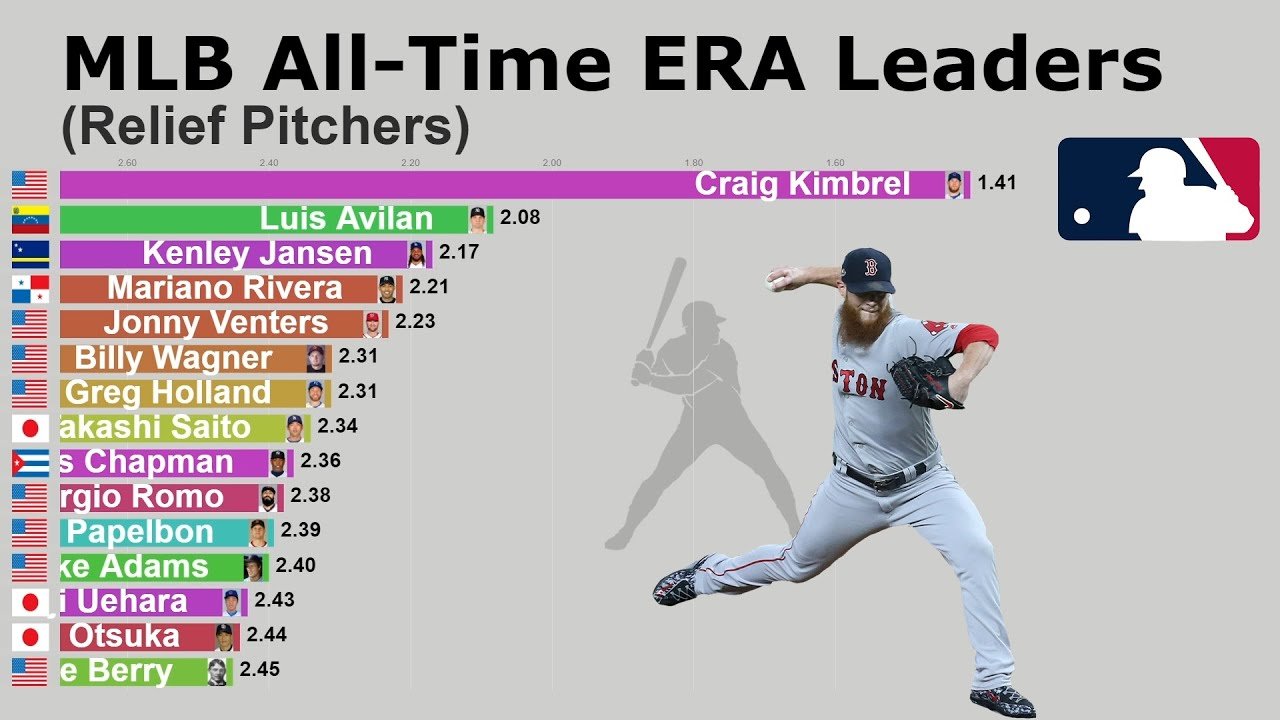ERA stands for Earned Run Average in baseball. It measures a pitcher’s performance.
This metric is crucial for evaluating how well a pitcher prevents runs. Baseball fans often hear about ERA, but what does it mean? Understanding ERA can help you appreciate the game more. It tells us how many earned runs a pitcher allows per nine innings.
This stat is vital in judging a pitcher’s effectiveness. A low ERA indicates strong performance, while a high ERA suggests struggles. Knowing ERA can deepen your insights into baseball strategies and player evaluations. Keep reading to learn how ERA is calculated and why it matters in baseball.
History Of Era
Understanding ERA (Earned Run Average) requires looking into its past. The history of ERA is fascinating and crucial to baseball statistics. It shows how the game and its analysis have evolved.
Origins Of Era
The concept of ERA began in the early 20th century. Baseball statisticians wanted a metric to gauge a pitcher’s effectiveness. They devised ERA to measure runs a pitcher allows per nine innings. This standard helped compare pitchers across different eras.
Evolution Over Time
ERA has undergone changes since its inception. Initially, it only accounted for earned runs. Later, rules were refined to ensure accuracy. Adjustments were made to exclude unearned runs caused by errors or passed balls. These changes made ERA a reliable statistic.
With advanced analytics, ERA continues to evolve. Modern metrics like FIP (Fielding Independent Pitching) emerged. They provide deeper insights. Yet, ERA remains a cornerstone of pitcher evaluation. Its enduring relevance speaks volumes about its importance in baseball.

Credit: www.wikihow.com
Calculating Era
Calculating Earned Run Average (ERA) is crucial for understanding a pitcher’s performance in baseball. ERA helps measure how many earned runs a pitcher allows per nine innings. It gives fans and analysts a clear picture of a pitcher’s effectiveness on the mound.
Formula For Era
The formula for calculating ERA is straightforward. You will need the total number of earned runs allowed and the total number of innings pitched.
ERA Formula:
ERA = (Earned Runs / Innings Pitched) 9
Breaking it down:
- Earned Runs: Runs scored without errors or passed balls.
- Innings Pitched: Total innings a pitcher has thrown.
Multiply the result by 9 to scale it to a standard game length.
Examples Of Era Calculation
Let’s look at a few examples to understand how to calculate ERA.
| Example | Earned Runs | Innings Pitched | ERA Calculation |
|---|---|---|---|
| Example 1 | 20 | 50 | ERA = (20 / 50) 9 = 3.60 |
| Example 2 | 15 | 45 | ERA = (15 / 45) 9 = 3.00 |
| Example 3 | 10 | 30 | ERA = (10 / 30) 9 = 3.00 |
These examples illustrate how ERA varies based on the pitcher’s performance. A lower ERA indicates a better pitching performance.
Impact Of Era On Pitchers
The Earned Run Average (ERA) is a crucial statistic in baseball. It measures a pitcher’s effectiveness. ERA calculates the average number of earned runs a pitcher allows per nine innings. This metric can deeply influence a pitcher’s career. Let’s explore how ERA impacts pitchers’ performance and career longevity.
Era And Pitcher Performance
A low ERA indicates a strong performance. Pitchers with lower ERAs are considered more effective. They give up fewer runs, helping their team win more games. Coaches and scouts closely watch ERA. It helps them identify the best pitchers. Here are some key points:
- Consistency: A low ERA over many games shows a pitcher’s consistency.
- Reliability: Teams rely on pitchers with low ERA during crucial moments.
- Recognition: Pitchers with low ERA often receive awards and accolades.
Pitchers aim to keep their ERA low. They use various strategies like improving their pitch accuracy. A lower ERA can also increase a pitcher’s confidence. This positive feedback loop helps them perform better.
Era And Career Longevity
ERA also affects a pitcher’s career longevity. A consistently low ERA can extend a pitcher’s career. Teams want pitchers who can maintain performance over the years. Here’s how a low ERA can impact career longevity:
| ERA Range | Career Impact |
|---|---|
| 1.00 – 2.00 | Highly desirable, long career likely |
| 2.01 – 3.00 | Very good, stable career |
| 3.01 – 4.00 | Average, decent career |
| 4.01 and above | Below average, shorter career expected |
Pitchers with lower ERA are more likely to get contract extensions. They are also more likely to be signed by other teams. Teams value pitchers who can control the game and reduce scoring opportunities for opponents.
In summary, ERA is a key indicator for pitchers. It affects both their performance and career longevity. Pitchers with lower ERA are highly valued in baseball.
Era In Modern Baseball
In modern baseball, the ERA (Earned Run Average) remains a vital statistic. It measures a pitcher’s performance by calculating the average number of earned runs they allow per nine innings. A low ERA indicates a strong pitcher. This metric offers fans and analysts insight into a pitcher’s effectiveness.
Era And Advanced Metrics
While ERA is essential, advanced metrics have gained popularity. These metrics, like FIP (Fielding Independent Pitching) and WHIP (Walks plus Hits per Innings Pitched), provide deeper analysis.
FIP focuses on the events a pitcher can control: strikeouts, walks, and home runs. It removes the impact of fielding. WHIP measures the number of base runners a pitcher allows per inning. Both metrics offer a more nuanced view of a pitcher’s ability.
Comparing Era Across Eras
Comparing ERA across eras can be challenging. Changes in the game, like the height of the mound and the quality of batters, affect ERA. A table can help visualize these changes:
| Era | Average ERA |
|---|---|
| 1900s | 2.50 |
| 1950s | 3.50 |
| 2000s | 4.50 |
As shown, the average ERA has increased over time. Various factors contribute to this, such as changes in batting techniques and the introduction of the designated hitter. Understanding these shifts is essential for an accurate comparison of pitchers from different eras.
Notable Era Records
In baseball, ERA or Earned Run Average is a key statistic. It measures the average number of earned runs a pitcher allows per nine innings pitched. This metric helps fans and analysts evaluate a pitcher’s effectiveness. Some pitchers have set remarkable ERA records, showcasing their skill and dominance on the mound. Let’s explore some of these notable ERA records.
Lowest Era In A Season
One of the most impressive records is the lowest ERA in a season. Bob Gibson holds this record in the modern era. In 1968, he achieved an ERA of 1.12. This performance is legendary and often cited in discussions about great pitching. Another notable mention is Dutch Leonard. In 1914, he recorded an ERA of 0.96. These figures highlight the exceptional control and talent of these pitchers.
Career Era Leaders
Consistency over an entire career is a different challenge. Ed Walsh tops the list with a career ERA of 1.82. He played from 1904 to 1917, maintaining this impressive average. Another great pitcher is Addie Joss. With a career ERA of 1.89, he ranks second. Both pitchers are celebrated for their sustained excellence.
Modern pitchers also feature in career ERA discussions. Mariano Rivera, a legendary closer, has a career ERA of 2.21. His precision and skill secured his place among the greats. These career ERA leaders have set standards for future generations of pitchers.

Credit: www.sportskeeda.com
Criticisms Of Era
In baseball, ERA (Earned Run Average) measures a pitcher’s effectiveness. But, it has faced criticisms over the years. Critics argue that ERA doesn’t always tell the full story. It has limitations that can mislead when evaluating a pitcher’s true performance.
Limitations Of Era
ERA doesn’t account for fielding errors. Errors can inflate a pitcher’s ERA unfairly. It also ignores the quality of defense behind the pitcher. A strong defense can lower ERA, while a weak defense can raise it.
ERA doesn’t factor in ballpark differences. Some parks are more hitter-friendly. This can lead to higher ERAs for pitchers in those parks. Also, ERA doesn’t consider the quality of opposition. Facing stronger hitters can negatively impact a pitcher’s ERA.
Relief pitchers are often judged by ERA too. This can be misleading because they pitch fewer innings. A few bad outings can greatly affect their ERA. Thus, ERA might not be the best measure for all pitchers.
Alternatives To Era
FIP (Fielding Independent Pitching) is one alternative. FIP only considers strikeouts, walks, and home runs. This eliminates the impact of fielding and luck. It gives a clearer picture of a pitcher’s skills.
WHIP (Walks plus Hits per Inning Pitched) is another metric. WHIP measures how many base runners a pitcher allows per inning. It can be a good indicator of a pitcher’s control and effectiveness.
ERA+ adjusts ERA for ballparks and league averages. It helps compare pitchers from different environments. An ERA+ of 100 is league average. Above 100 is better than average, and below 100 is worse.
WAR (Wins Above Replacement) is a comprehensive metric. It considers all aspects of a player’s contributions. For pitchers, WAR includes ERA, innings pitched, and defensive support. It provides a complete picture of a pitcher’s value.
Frequently Asked Questions
What Does Era Mean In Baseball?
ERA stands for Earned Run Average. It measures how many earned runs a pitcher allows per nine innings. It’s a key statistic in evaluating a pitcher’s effectiveness.
How Is Era Calculated In Baseball?
ERA is calculated by dividing the total earned runs allowed by the number of innings pitched, then multiplying by nine. This gives the average number of earned runs per nine innings.
What Is A Good Era In Baseball?
A good ERA in baseball is typically below 3. 00. This indicates strong pitching performance. An ERA above 4. 50 is generally considered poor.
Why Is Era Important In Baseball?
ERA is important because it provides a clear measure of a pitcher’s effectiveness. It helps coaches and scouts evaluate performance and make strategic decisions.
Conclusion
Understanding ERA in baseball is essential for fans. It measures a pitcher’s effectiveness. Lower ERA means better performance. Fans can enjoy the game more. They appreciate the skills of pitchers. ERA adds depth to baseball knowledge. It also sparks discussions among enthusiasts.
Knowing ERA enhances viewing experience. It makes the game more exciting. So, next time, check the ERA. Enjoy the insights it brings. Happy watching!





